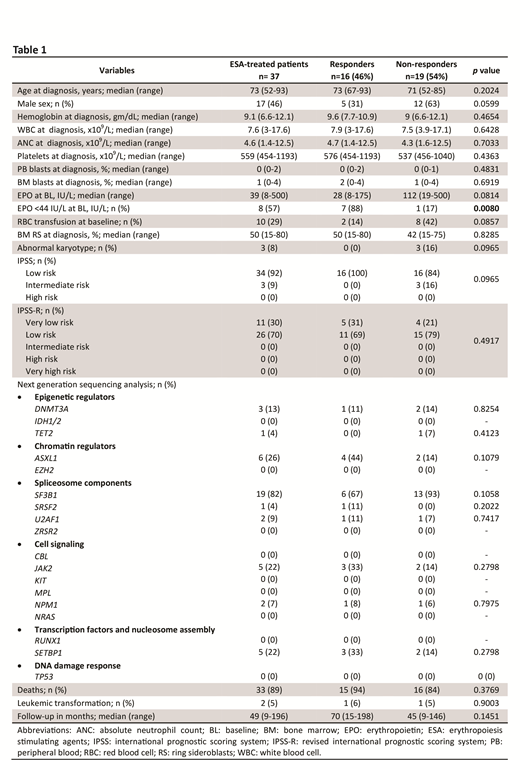Background: Myelodysplastic syndrome (MDS)/myeloproliferative neoplasm (MPN) with ring sideroblasts and thrombocytosis (MDS/MPN-RS-T) was formally included as a unique WHO-defined entity in the 2016, iteration of the classification of hematological neoplasms (under MDS/MPN overlap syndromes). Patients with MDS/MPN-RS-T have features of MDS-RS-single lineage dysplasia (SLD), persistent thrombocytosis (platelet count ≥450x109/L), with proliferation of large atypical megakaryocytes. Anemia, including red blood cell transfusion dependency (RBC-TD) is a major problem. While extensive studies have documented erythroid response rates (ERR) to erythropoiesis stimulating agents (ESA) in MDS and MDS-RS-SLD, the data in MDS/MPN-RS-T is less clear. We carried out this study to asses ERR in ESA treated patients with MDS/MPN-RS-T.
Methods: After approval by the IRB, patients with 2016, WHO-defined MDS/MPN-RS-T were included in the study. The bone marrow (BM) morphology, cytogenetics and BM RS% were retrospectively reviewed. All study patients underwent next generation sequencing for 29 myeloid-relevant genes, obtained on BM mononuclear cells, at diagnosis, or at first referral, by previously described methods (Patnaik et al., BCJ 2016). Treatment details, including the type of ESA used, dose administered, side effects and reason for discontinuation were retrospectively abstracted. Erythroid responses were assessed using the 2006, international working group (IWG) MDS and the 2015, IWG MDS/MPN response criteria.
Results: Forty seven patients with MDS/MPN-RS-T were identified, of which 37 (79%) patients received ESA treatment at any time point during their disease course; median age 73 years (range, 52-93), 46% male.The hemoglobin at diagnosis (HB) and baseline erythropoietin (EPO) levels were 9.1 gm/dL (range, 6.6-12.1) and 39 IU/L (range, 8-500), respectively. Ten (29%) patients were RBC-TD at baseline. None of the 37, ESA-treated patients were on concomitant cyto-reductive therapy for thrombocytosis. Twenty (54%) patients were treated with erythropoietin-a, 13 (35%) with darbepoetin, and 4 (11%) with both sequentially. Median doses were 40,000 IU weekly (range, 20,000-80,000) for erythropoietin-a and 200 mcg every 2 weeks (range, 100-500), for darbepoetin. Median treatment duration was 14 months (range, 1-173) and causes for discontinuation included; ESA failure/loss of response in 20 (54%), sustained HB rise in 1 (3%) and other causes, including adverse events in 4 (11%) patients. With regards to safety, the following events were considered potentially ESA related; treatment emergent hypertension in 2 (5%), venous thromboembolism, ischemic stroke and splenic infarction in 1 (3%) patient each, respectively. All patients with thrombotic/ischemic events had been on low dose aspirin prophylaxis.
Erythroid responses by the IWG MDS and MDS/MPN response criteria were assessable in 35 (95%) patients: with 16 (46%) meeting criteria for an erythroid response, by both assessment systems. The median duration of ER was 20 months (range, 2-172). In comparison to ESA non-responders, those that responded were more likely to have baseline EPO levels ≤44 IU/L (ROC analysis; median, 28 vs 112 IU/L; p=0.0080), while there was a trend for inferior responses associated with RBC-TD (p=0.0857). Age, gender, baseline white blood cell and platelet counts, type of ESA used, BM RS %, JAK2V617F, SF3B1, DNMT3A, TET2 and ASXL1 mutational status did not impact ESA response (Table 1). On a univariate survival analysis (OS), survival was not significantly different between ESA responders vs non-responder (median OS, 76 vs 45 months; p=0.2929).
After ESA failure, 7 (19%) patients received hypomethylating agents (HMA), while 5 (14%) received lenalidomide. There were no erythroid responses to HMA, while 1 of 3 (33%) assessable lenalidomide treated patients achieved a morphological complete response.
Conclusion: Erythropoiesis stimulating agents are effective first line therapies for the management of anemia in patients with MDS/MPN-RS-T, with 46% achieving an erythroid response (median duration of response of 20 months). Low baseline endogenous EPO level (<44 IU/L) was the best predictor of response, with a trend towards an inferior response in the presence of RBC-TD. In the context of clonal thrombocytosis, potentially related thrombotic/ischemic events were documented in 8% of patients.
Al-Kali:Astex Pharmaceuticals, Inc.: Research Funding. Patnaik:Stem Line Pharmaceuticals.: Membership on an entity's Board of Directors or advisory committees.
Author notes
Asterisk with author names denotes non-ASH members.


This feature is available to Subscribers Only
Sign In or Create an Account Close Modal